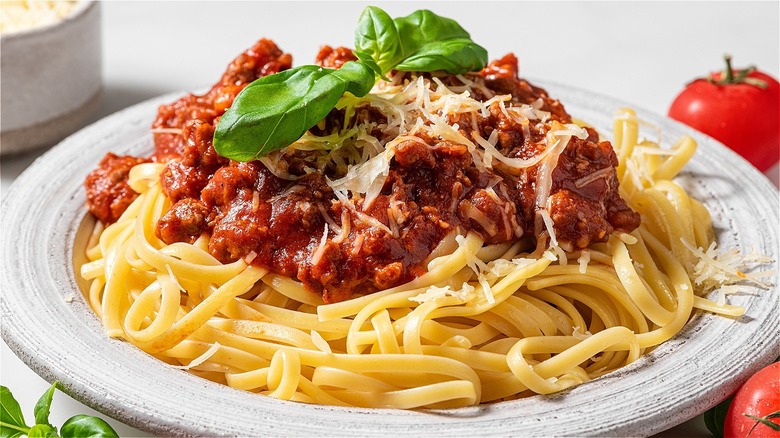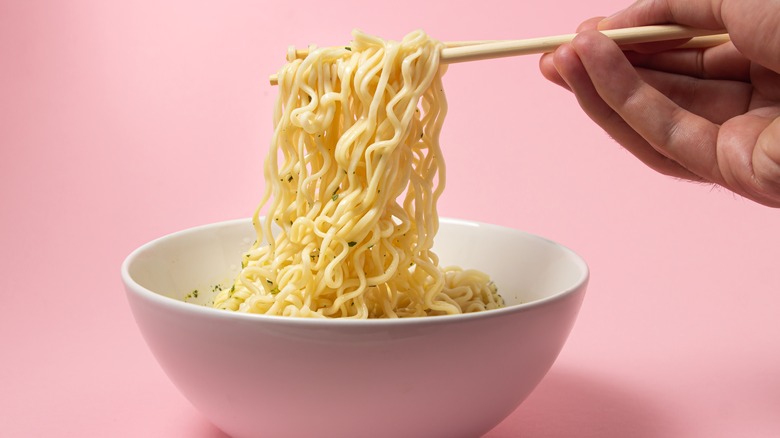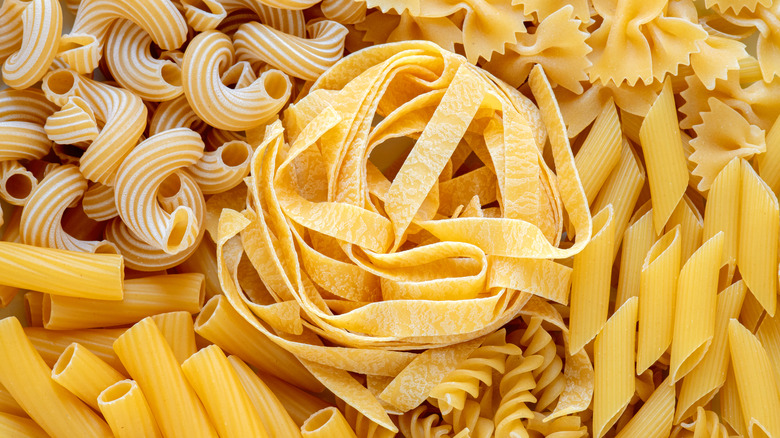Pasta Probably Didn't Originate In Italy
When pasta is mentioned, most people might automatically associate it with Italian cuisine. From carbonara to the almost mac-and-cheese-like cacio e pepe, Italy is well known for cranking out some of the world's most beloved pasta recipes. For a country with such deep traditions in pasta making, one would assume the food's origins are origins obvious.
As it turns out, the history of this beloved carbohydrate is a lot more complicated. The invention of modern-day pasta is still highly contested, with people debating theories of Chinese, Arabic, Greek, or Italian origins. Many sources, for instance, point to China as the birthplace of pasta, citing its role in creating different types of Asian-style noodles that pre-date their Italian counterparts. But it's unclear if these ancient noodles were historically connected to the pasta we're familiar with today.
One argument maintains that pasta and noodles are completely separate entities, resulting from different cultures, geographies, processing methods, and available ingredients. While they're similar, they aren't interchangeable. "Pasta" generally refers to Italian-style dough made with high-protein durum wheat flour. Noodles are produced with common heat flour. However, such definitions aren't entirely straightforward.
For example, the Chinese words for what many people might call noodles ("miàn" or "mein") refer to food made from flour and liquid, encompassing noodles and dumplings. To make matters even more confusing, we can't prove whether the use of terms like "pasta" in historical records simply described various foods that used the same ingredients. With these issues in mind, let's have a deeper look at the evidence.
Pasta's possible Chinese origins
Long before pasta had made its way to Italy, the Chinese were already developing the art of noodle making. In 2005, archaeologists unearthed what they thought was a 4,000-year-old bowl of noodles in northwestern China (via National Geographic). This was the earliest evidence of noodles, but some claim that additional information is needed to prove their noodle-ness in comparison to both modern and ancient versions.
After analyzing the unearthed noodles, they were revealed to be made with millet, rather than wheat. Millet, a gluten-free grain, doesn't have the proper qualities for noodle dough, and historian François Sabban questions the validity of the excavation. Sabban claims that the lack of gluten would have made it impossible to make hand-pulled noodles, and also calls into question the lack of grain processing tools at the site (via Hypotheses).
While controversy may cloud this historic discovery, other written evidence proves that China is the source of noodles. Early written references were discovered in an ancient Chinese dictionary, dating noodles back to the Han Dynasty (206 B.C. – 220 A.D.). But pasta is still a different story, and a big source of contention is the source of grains. At the time, China was only able to grow soft wheat, while the pasta found in Europe and the Middle East used coarser grains. The two grains would have created very different products, leading some historians to believe that pasta did not originate from Chinese noodles.
If not China, then where?
Legends claimed that it was Marco Polo who brought pasta back from his travels along the Silk Road. Unfortunately for him, this claim was disproven by evidence that documents pasta in Italy centuries before Polo began his travels.
Some believe there is archaeological evidence of pasta in the Etruscan civilization (a pre-Roman society located in central Italy) from as early as the fourth century B.C., found in an unearthed tomb. The tomb revealed kitchen tools that resemble those used for making pasta today. Critics argue that the tools had multiple uses, and the lack of other pasta references further challenges the theory.
Others believe that the Italians were exposed to pasta by their Greek neighbors. According to food historian Giorgio Franchetti, "Between 1000BC and 800BC, the Greeks first mentioned the existence of laganon, a flat pasta sheet sliced into irregular strips that was later adopted by the ancient Romans with the plural name of laganae" (via South China Morning Post).
Another theory is that pasta made its way to the Mediterranean region through Arabic nomads. A version known as rishta could have come to Italy through the island of Sicily, which was once occupied by the Arabs. Further evidence appears to link the invention of dried pasta to the Arab nomads. Food historian Anna Maria Pellegrino suggests that noodles and pasta could have been created around the same time in different parts of the world, merely as a product of human advancement.


